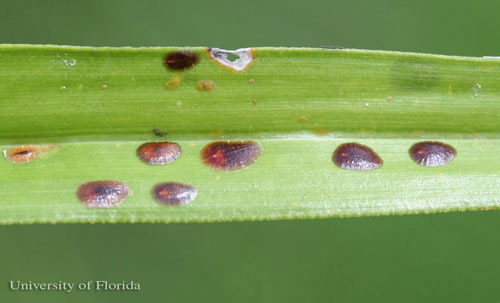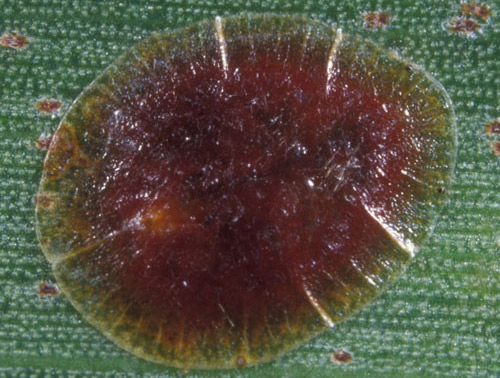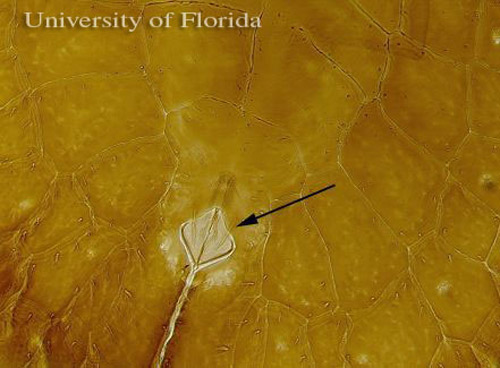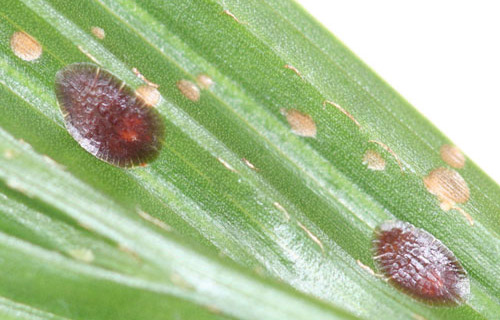common name: tessellated scale
scientific name: Eucalymnatus tessellatus (Signoret) (Insecta: Hemiptera: Coccidae)
Introduction - Distribution - Field Characteristics - Life Cycle - Hosts - General Plant Damage - Management - Selected References
Introduction (Back to Top)
The tessellated scale, Eucalymnatus tessellatus (Signoret), is a soft scale (Hemiptera: Coccoidea) that is believed to be native to South America. This species may be a pest in greenhouses, commercial nurseries, and in the south Florida landscape (Dekle 1973). Palms, crepe-jasmine, and mango are some of the common south Florida hosts in the landscape for this pest.
Figure 1. Adult tessellated scales, Eucalymnatus tessellatus (Signoret), infesting palm. Photograph by Forrest Howard, University of Florida.
Distribution (Back to Top)
This scale is widely distributed and has been found in Africa, Australia, North, Central and South America, the Caribbean, Asia and Europe. Tessellated scale has been found throughout Florida, and is frequently found on palm species.
Field Characteristics (Back to Top)
The adult female body is often slightly asymmetrical, oval or pear shaped, measuring 0.098-0.196 inches (2-5 mm) long, and 0.078-0.118 inches (2-3 mm) wide. It looks flat when viewed from the side. It is reddish to dark brown in color. It has polygonal, sclerotized plates on the dorsum (top surface) with a raised ridge on the median area. It does not have a wax cover or ovisac. No males are known to occur. Legs are well developed compared to most soft scale insects (Hamon and Williams 1984, Miller et al. 2007).
Figure 2. Adult female tessellated scale, Eucalymnatus tessellatus (Signoret). Photograph by Paul Choate, University of Florida.
Figure 3. Sclerotized anal plate on top surface (dorsum) of tessellated scale, Eucalymnatus tessellatus (Signoret). Photograph by Adriana Espinosa, University of Florida.
Life Cycle (Back to Top)
One or two generations occur per year in a natural setting, but more frequent, overlapping generations may occur within greenhouse environments. They are parthenogenic (i.e. reproduce asexually without mating) and ovoviviparous, meaning that the eggs hatch within the female body, and the female gives birth to live young scale crawlers, or in some cases lay eggs that hatch quickly. This species has a relatively low reproduction rate among scale insects, producing less than two dozen young per female (Vesey-Fitzgerald 1940). They are usually found on leaves and stems (Hamon and Williams 1984).
Hosts (Back to Top)
Tessellated scale has a very wide host range that includes monocot and dicot plant species such as ornamentals and fruit trees.
Figure 4. Adult tessellated scales, Eucalymnatus tessellatus (Signoret), infesting palm. Photograph by Forrest Howard, University of Florida.
Tessellated scale is particularly common on palm species (family Arecaeae) and it specifically attacks the following:
- Areca, yellow-cane-palm, Areca spp.
- Arenga spp.
- fishtail palms, Caryota spp.
- Kentia palm, Howeia forsterana
- coconut palm, Cocos nucifera
- Lantanier jaune, Latania verschaffeltii
- Chinese fan palm, Livistona chinensis
- Attap palm, Nypa fruticans
- Canary Island date palm, Phoenix canariensis
- date palm, Phoenix dactylifera
- miniature date palm, Phoenix roebelinii
- lady palm, Rhapis spp.
- Washington palm, Washingtonia spp.
In addition to palm species, some other hosts of tessellated scale include species in the following plant families:
- Acanthaceae - Sanchezia spp.
- Anacardiaceae - Mangifera indica (mango)
- Apocynaceae - Nerium oleander, Plumeria rubra
- Aquifoliaceae - Ilex cassine (Dahoon holly)
- Araceae - Anthurium spp.
- Caricaceae - Carica papaya (papaya)
- Curcubitaceae
- Lauraceae - Cinnamomum, Laurus, Litsea, and Persea spp.
- Moraceae- Ficus spp.
- Myrtaceae - Eucalyptus, Eugenia, and Myrtus spp.; Psidium guajava (guava)
- Oleaceae - Jasminum
- Pittosporaceae - Pittosporum spp.
- Rubiaceae - Coffea and Gardenia spp.
- Rutaceae- Citrus spp.
- Sapindaceae - Euphoria longana (longan), Litchi chinensis (litchi)
A complete host reference list is available at ScaleNet: A Database of Scale Insects of the World.
General Plant Damage (Back to Top) (Back to Top)
Heavy infestations can weaken or even kill a host plant. In commercial nurseries, infestations may become of economic importance when not controlled. For example, in a dense planting of 'Malayan Dwarf' coconut palms in Miami, a serious infestation of E. tessellatus with up to 200 mature female scale insects per pinna has been observed. This planting had been sprayed repeatedly with insecticides to control palm aphid, Cerataphis brasiliensis (Hempel) without much success, and it is thought that the treatments may have interfered with natural enemies of both aphids and tessellate scale. Most of the foliage of these palms was coated with a thick crust of sooty mold, which was undoubtedly supported by the honeydew of both the palm aphids and the tessellated scale (Howard et al. 2001).
Management (Back to Top)
Metaphycus stanleyi (Hymenoptera: Encryptidae) is a common natural enemy of this scale. A fungus, Verticillim lecanii (Zimmerman) Viegas, has been reported attacking E. tessellatus in the Seychelles (Vesey-FitzGerald 1940). This is a cosmopolitan fungus that attacks many kinds of insects and that has been developed as a biocide.
General management of scale insects begins with detection and identification of the pest. Scale insects can be very small or resemble disease organisms or even plant structures, making detection difficult. Regular monitoring will allow detection of these pests before damage is obvious and will also allow improved control. All plant parts, including the underside of leaves and stems, need to be searched. Inspection of plants prior to introducing them into the landscape, nursery or collection is very important in reducing new infestations of scales.
Management of scale insects can be difficult to control because of the waxy covering they produce which provides protection from many of the insecticides. Pruning or washing infested plant parts can be helpful in reduction scale populations, particularly in cases of small infestations. A brisk wash spray of water can also be helpful in removing scales from plants and reducing the population. Scale insects are commonly attacked by predators, parasites and diseases which can help manage scale populations particularly for long term control. It is important to recognize the presence of beneficial insects and to take steps to conserve them in the environment so they are available to control the pest insects.
It is often necessary to manage scale insects with insecticides so it is important to select appropriate insecticides, timing and application methods to reduce negative impact on the natural enemies but still get maximum control. Contact insecticides commonly provide quick knockdown of the pest but require good coverage and typically repeat applications. The stage most susceptible to contact insecticides is the crawler stage. Horticultural oil and insecticidal soaps also can provide good control, but must be treated like a contact insecticide which requires thorough coverage and repeat applications. Systemic insecticides can provide excellent options for scale control and can provide some flexibility in application timing and methods. These insecticides move up through the plant and provide an excellent way to expose scale insects to the insecticide when they feed on the plant. It is important to not overuse or misuse insecticides which can lead to numerous problems including insecticide resistance. To avoid insecticide resistance it is critical to rotate among insecticide groups.
Tessellated scale is common on palms, but usually occurs in very sparse populations such as a few individuals on a frond or even on an entire palm. Damaging populations are most apt to be brought about by interference in natural control, as in the above example. Also, this scale insect could occur in dense populations if introduced into a new region without its natural enemies.
Selected References (Back to Top)
- Buss EA,Turner JC. (June 2006). Scale insects and mealybugs on ornamental plants. EDIS. (no longer available online)
- Dekle GW. 1973. Tessellated scale, Eucalymnatus tessellatus (Signoret). Florida Department of Agriculture, Division of Plant Industry, Entomology Circular 138: 1-2.
- Hamon AB, Williams ML. 1984. Arthropods of Florida and Neighboring Land Areas: The Soft Scale Insects of Florida (Homoptera :Coccoidea: Coccidae). Florida Department of Agriculture and Consumer Services, Division of Plant Industry.
- Howard FW, Moore D, Giblin-Davis RM, Abad R. 2001. Insects on Palms. CABI Publications, Wallingford, UK. 400 pp.
- Miller DR, Rung A, Venable GL, Gill RJ. 2007. Scale Insects: Identification tools, images, and diagnostic information for species of quarantine significance CD-ROM. Systematic Entomology Laboratory USDA-ARS.
- Vesey-FitzGerald D. 1940. The control of Coccidae on coconut in the Seychelles. Bulletin of Entomological Research 31: 253-286.



